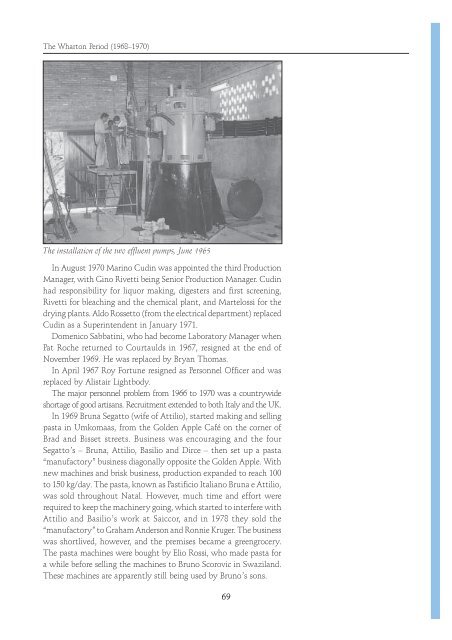Create successful ePaper yourself
Turn your PDF publications into a flip-book with our unique Google optimized e-Paper software.
<strong>The</strong> Wharton Period (1968–1970)<br />
<strong>The</strong> installation of the two effluent pumps, June 1965<br />
In August 1970 Marino Cudin was appointed the third Production<br />
Manager, with Gino Rivetti being Senior Production Manager� Cudin<br />
had responsibility for liquor making, digesters and first screening,<br />
Rivetti for bleaching and the chemical plant, and Martelossi for the<br />
drying plants� Aldo Rossetto (from the electrical department) replaced<br />
Cudin as a Superintendent in January 1971�<br />
Domenico Sabbatini, who had become Laboratory Manager when<br />
Pat Roche returned to Courtaulds in 1967, resigned at the end of<br />
November 1969� He was replaced by Bryan Thomas�<br />
In April 1967 Roy Fortune resigned as Personnel Officer and was<br />
replaced by Alistair Lightbody�<br />
<strong>The</strong> major personnel problem from 1966 to 1970 was a countrywide<br />
shortage of good artisans� Recruitment extended to both Italy and the UK�<br />
In 1969 Bruna Segatto (wife of Attilio), started making and selling<br />
pasta in Umkomaas, from the Golden Apple Café on the corner of<br />
Brad and Bisset streets� Business was encouraging and the four<br />
Segatto’s – Bruna, Attilio, Basilio and Dirce – then set up a pasta<br />
“manufactory” business diagonally opposite the Golden Apple� With<br />
new machines and brisk business, production expanded to reach 100<br />
to 1<strong>50</strong> kg/day� <strong>The</strong> pasta, known as Pastificio Italiano Bruna e Attilio,<br />
was sold throughout Natal� However, much time and effort were<br />
required to keep the machinery going, which started to interfere with<br />
Attilio and Basilio’s work at <strong>Saiccor</strong>, and in 1978 they sold the<br />
“manufactory” to Graham Anderson and Ronnie Kruger� <strong>The</strong> business<br />
was shortlived, however, and the premises became a greengrocery�<br />
<strong>The</strong> pasta machines were bought by Elio Rossi, who made pasta for<br />
a while before selling the machines to Bruno Scorovic in Swaziland�<br />
<strong>The</strong>se machines are apparently still being used by Bruno’s sons�<br />
69

















